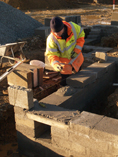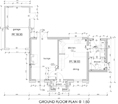 St Just In Roseland
St Just In Roseland
Cornish collection of six homes on a Community Land Trust site…
Background:
- This project was initiated by two local brothers – one a joiner, one a stone mason – who, on their wages, simply couldn’t afford to buy a house in this part of Cornwall. So they formed a close-knit local group, with four other locally born people who were involved in the construction sector, to see if they could get a cost effective group self build project off the ground.
- They negotiated with a local farmer to buy a field on the edge of the village. The land was not zoned for housing, but with support from the local parish council they were optimistic that permission would be granted.
- The site did come with a few challenges – there was a high voltage cable passing over it, and two nearby homes had septic tanks, with their outfall pipes under a corner of the field. There were also issues with connecting up to the mains water supply, and getting a formal right of access via a car park that was owned by the parish and local district council.
- The council was concerned that the group might build the homes and then sell them on, so they wanted to structure the project so that – if anyone ever moved, the homes could only be sold to someone local who was on modest wages. The council decided therefore to buy the field from the farmer, set the site up as a Community Land Trust (CLT), and form a board of trustees to oversee the site and draw up the basic rules. The CLT then transferred the freehold of the individual plots to each of the six families involved. A management company was formed by the six builders to take care of the roads infrastructure and the sewerage pumping station – and these areas were also transferred by the CLT. This approach was probably well intentioned but it ended up making it quite difficult for the group, and the individuals involved had many disagreements with the trustees of the CLT.
Delivery:
- The group of six that are currently building their homes are aged 30-45. They are all local couples, and between them they have four children. Two are masons, one is a joiner, two are electricians, and one is a plumber. They all work for a couple of local small contractors.
- The biggest problem they had to resolve was the septic tank outfalls from the neighbouring homes that ran into a corner of the field. The farmer’s solicitor – who originally granted the neighbours an easement for their septic tank outfalls – did not include a clause that gave the farmer the right to adjust the easement in the future. So the neighbours – who objected to any new houses next door – refused to connect up to the much better sewerage system that the self builders were installing. This impasse still hasn’t been resolved, and the net result is that about a quarter of the site is still blighted (there were originally plans for eight homes; and only six are currently being built).
- In the early planning stages the self builders also went overboard on professional consultants fees. The architects they used convinced them to do more detailed drawings than were probably required (at that stage); and the same was true of the engineers – who designed all the highways and sewerage systems in fine detail up front. The solicitors that were involved also racked up significant fees, setting up the CLT, liaising with the farmer, the council, the neighbours and everyone else.
- At the time this case study was written (early 2012) the homes were on site and progressing well. All six are being built collectively and each consists of a three bed property of about 100 sq m. They are timber framed and faced with natural stone at ground level and rendered above. They all have slate roofs. Ground source heat pumps are planned to provide most of the space and water heating.
Finance:
- The Council paid £30,000 to buy the field from the farmer and set up the CLT. Each of the plots were then transferred to the self builders by the CLT for £1.
- The cost of all the professional fees was significant – the legal, architects and engineers costs over several years had soared. This, together with the costs of installing the access road and sewerage pumping station is likely to add up to around £240,000 – so a levy of some £40,000 per home. If the two self build plots that are currently blighted are eventually used, each of the six initial self builders will get a small rebate.
- A project manager was hired by the group and the council to help sort out the legal and technical issues that were holding it up and to help manage the budget for the project when on site. He has been paid £12,000 for his input.
- The construction cost of each home has been kept very low, as the self builders have done all the physical work themselves. Typically each home is expected to cost about £60,000 – the bulk of this will be the cost of the materials, though they have used some sub-contractors for certain bits of the work. Their chums in the building industry have also pitched in at weekends to keep costs down too.
- There is no formal agreement about how many hours are put in each week; the close knit team works on trust with everyone broadly pulling their weight.
- The net result is that each home will cost about £100-110,000. Typical homes of about the same size in the village are at least double this price. Most of the builders financed the construction work from savings or informal loans from family members. They will end up with modest self build mortgages to cover any outstanding amounts.
Timescale:
- 2003/4 – The self builders got together and formed themselves into a group and identified the potential site.
- Late 2010 – The builders are granted a licence that enabled them to occupy the site.
- Early 2011 – Work begins on the foundations of the six homes.
- January 2012 – The homes are now watertight, and internal fitting out work is underway.
- Spring 2012 – The sewerage pumping station and road is due to go in.
- Summer 2012 – Everyone should have moved in.
Learning Points:
- The use of a CLT to structure the way a group site like this is managed into the future seems like a good idea, but if the trustees are inexperienced it can result in an “us and them” scenario emerging. It could be argued that the CLT was one layer too much, and that the self builder’s own management company could have been constituted in some way so that it protected the homes for affordable and local use into the future.
- The saga with the neighbours who didn’t want to co-operate over their sewerage outfalls is typical of the sort of thing that sometimes happens on projects like this. It’s essential to check all the small print when land is being bought. And if you end up in a legal wrangle the fees can be astronomic.







